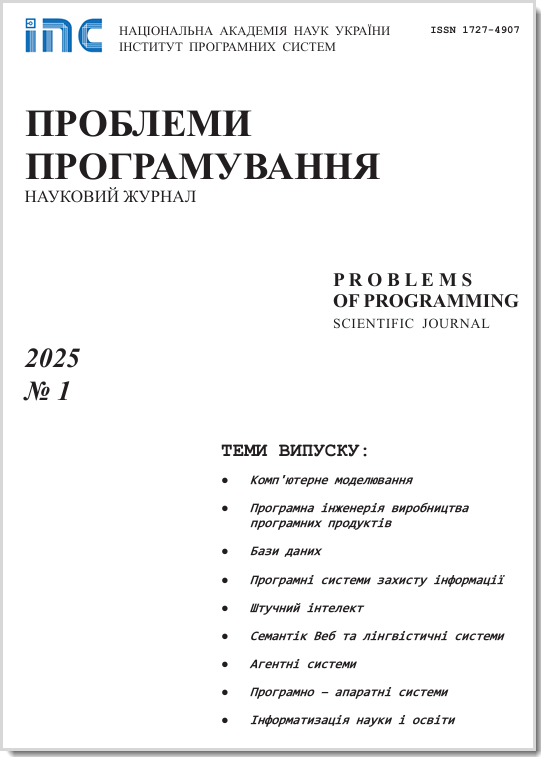Use of ontologies for search and navigation improvement in the online version of the "Great ukrainian encyclopedia"
Abstract
The aim of the work is to analyze the means of semantic search in Wiki resources and to develop directions for expanding its capabilities through the use of modern tools of knowledge management. The article analyzes the benefits that the use of semantic markup of the Web information resources provides for users by more convenient and quick access to content. The techniques of application of ontological analysis for search and navigation in semantized Wiki resources are considered. The definition of Wiki ontology that formalizes the information about the structure of the knowledge base of information resource (both ordinary and semantized) based on Wiki technology is proposed. The theoretical foundations of determining the measure of semantic similarity between domain concepts based on ontologies and taxonomies are analyzed. Methods of design of navigation tools oriented on Wiki resources are proposed. These methods are based on retrieval of pages that use semantically related concepts. The implementation of the proposed approach in the online version of the Great Ukrainian Encyclopedia (e-VUE) is described. Such approach supports an extension of the functionality of the encyclopedic resource by providing means of access to content on a semantic level. The methodological principles of the organization of the e-VUE knowledge base and the categorization of its articles that ensure the use of semantic proximity estimations between domain concepts for discovery of such concepts are substantiated.
Problems in programming 2019; 4: 11-27
Keywords
Full Text:
PDF (Українська)References
Semantic MediaWiki. - https://www.semantic-mediawiki.org/wiki/ Semantic_MediaWiki
Guarino N. Formal Ontology in Infor-mation Systems. Formal Ontology in In-formation Systems. Proc. of FOIS'98. 3-15. 1998.
Ushold M., Gruninger M. Ontologies: Prin-ciples, Methods and Applications. Know-ledge Engineering Review. 1996. Vol. 11, N 2. CrossRef
Asuncion G. Ontological Engineering: with Examples from Areas of Knowledge Man-agement, e-Commerce and the Semantic Web (Advanced Information and Knowledge Processing). - http://www.amazon.com/gp/reader/ 1852335513/ref=sib_rdr_toc/.
Rogushina J. Semantic Wiki resources and their use for the construction of personal-ized ontologies. CEUR Workshop Proceed-ings 1631. 2016. P. 188-195.
Rogushina J. (2018) Theoretical means of ontology use for the Web resources semantization. Problems in Programming. N 2-3. P. 197-203. [in Ukrainian] CrossRef
W3C Semantic Web Activity. -http://www.w3.org/2001/sw/Activity/.
Rogushina Y.V., Priyma S.M, Strokan O.V. (2017) Creating and use of the Semantic Wiki resources: tutorial. Melitopol, FOP Odinorog T.V. 169 p. [in Ukrainian]
Quillian M.R. Semantic memory. In Minsky, M. (Ed.), Semantic Information Pro-cessing. MIT Press, Cambridge, MA, 1968.
Collins, A., Loftus, E. A spreading activation theory of semantic processing. Psychological Review. 1975. 82. P. 407-428. CrossRef
Rada R., Mili H., Bicknel E., Blettner M. Development and application of a metric on semantic nets. IEEE Transaction on Systems, Man, and Cybernetics. 1989. 19(1). P. 17-30. CrossRef
Richardson R., Smeaton A.F., Murphy J. Using WordNet as a knowledge base for measuring semantic similarity between words. Working paper CA-1294, Dublin City University, School of Computer App-Ucations, Dublin, 1994. ftp://ftp.compapp. dcu.ie/pub/w-papers/1994/CA1294.ps.Z
Lee J.H., Kim M.H., Lee Y.J. Information retrieval based on conceptual distance in IS-A hierarchies. Journal of Documenta-tion. 1993. 49(2). P. 188-207. CrossRef
Rada R., Bicknell E. Ranking documents with a thesaurus. JASIS. 1989. 10(5). P. 304-310. CrossRef
Leacock C., Chodorow M. WordNet: An electronic lexical database. Cambrige. 1998. P. 265.
Miller G. WordNet: An on-line lexical database. International Journal of Lexicog-raphy, 3(4). (Special Issue). 1990. CrossRef
Wu Z., Palmer M. Verb semantics and lex-ical selection. Proc. 32nd Annual Meeting of the Association for Comput. Linguistics. Las Cruces. 1994. P. 133-138. CrossRef
Resnik P. Semantic Similarity in a Taxon-omy: An Information-Based Measure and its Application to Problems of Ambiguity in Natural Language. Journal of Artificial Intelligence Research. 1999. 11. P. 95-130. CrossRef
Kriukov K.V., Pankova K.V., Pronina V.A., Shipilina L.B. (2010) Measures of semantic proximity in ontologies. Proc.of MIFI-2010, Vol. 5. Information- telecommunication systems. Problems of information security. P. 75-78. [in Russian]
Tversky A. Features of Similarity. Psychological Rev. 1977. Vol. 84. P. 327. CrossRef
Bulskov H., Knappe R., Andreasen T. On Measuring Similarity for Conceptual Querying. Proc. 5th Int. FQAS Conf. LNCS. V. 2522. Berlin: Springer. 2002. P. 100. CrossRef
Levenshtein I.V. Binary codes capable of correcting deletions, insertions, and reversals. Cybernetics and Control Theory. 1966. Vol. 10. P. 707.
Methodical recommendations for preparing, editing and design of articles for Great Ukrainian Encyclopedia (2015) / Ed. Kyrydon A.M., Kyiv, Kyiv, 120 p. [in Ukrainian]
Rogushina J.V. (2017) The Use of Ontological Knowledge for Semantic Search of Complex Information Objects // Proc. of OSTIS-2017. P. 127-132.
Rogushina J.V. (2017) Use of semantic properties of the Wiki resources for expansion of functional posibilities of "Great Ukrainian Encyclopedia". Encyclopaedias in the modern information space: collective monograph / Ed. Kyrydon A.M., Kyiv. P. 104-115. [in Ukrainian]
Grishanova I.Y, Rogushina J.V. (2018) Adaptation of technological means of Semantic Mediawiki for needs of online version of Great Ukrainian Encyclopedia // Encyclopaedias in Ukraine: people, ideas, steps: collective monograph / Ed. Kyrydon A.M., Kyiv. P. 240-253. [in Ukrainian]
DOI: https://doi.org/10.15407/pp2019.04.011
Refbacks
- There are currently no refbacks.



